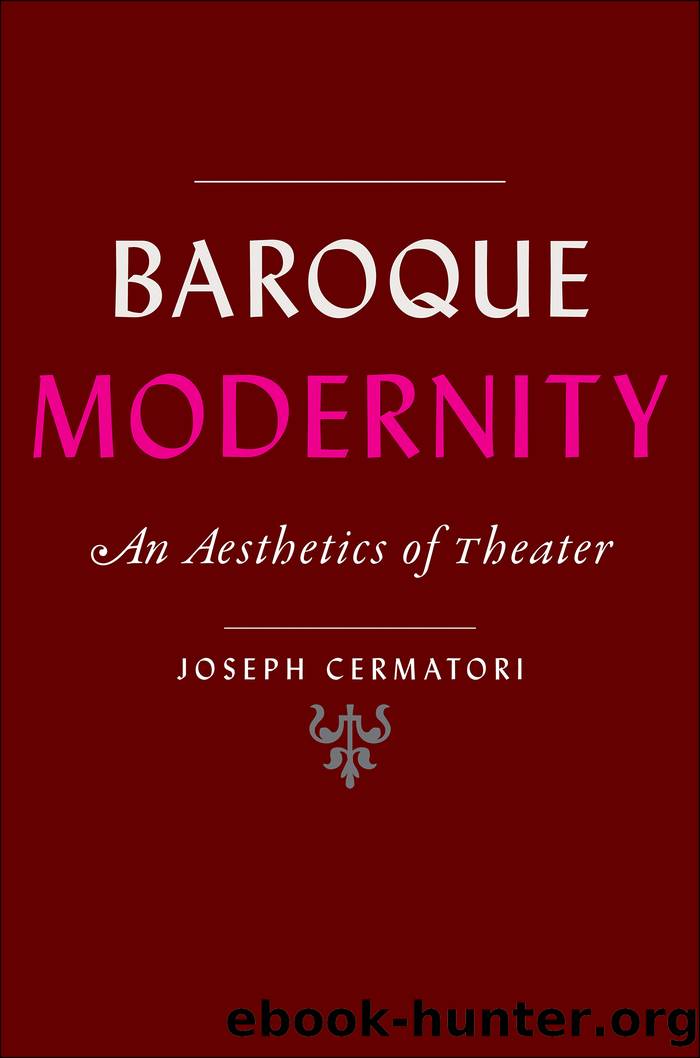Baroque Modernity by Joseph Cermatori;

Author:Joseph Cermatori;
Language: eng
Format: epub
Publisher: Johns Hopkins University Press
Published: 2021-06-15T00:00:00+00:00
âTo Mount It UpââBaroque Citationality on Stage
Upon entering the Wadsworth Atheneumâs newly built theater in Hartford, Connecticut, for the 1934 premiere of Four Saints, spectators received a printed program made of pink paper and black Spanish lace that set the tone for the events to follow. For its frontispiece, this program featured a photograph of Berniniâs Saint Teresa in Ecstasy (ca. 1650) along with a lengthy excerpt from Richard Crashawâs hymn to Saint Teresa (also ca. 1650), âThe Flaming Heart.â8 These baroque intertexts were no accident. Stein came to be situated alongside Bernini and Crashaw in this way, in no small part, through the influence of the Atheneumâs new chief curator, Arthur Everett âChickâ Austin (1900â1957). In the seven years since his appointment as museum director at age twenty-seven, Austin had sought to focus the museumâs collecting on two then-undervalued fields of European paintingâthe same two art-historical periods that were his lifelong passion, namely, the modernist and the baroque. He had already curated the first major American exhibition of Italian baroque paintings, in 1930.9 Through his efforts, a new awareness of baroque visual art had come sharply into focus among American museumgoers and collectors. On the occasion of Four Saintsâ premiere, Austin also inaugurated the Atheneumâs newly completed Avery Memorial Wing, which he had arranged to be built in the austere International Style, and at whose center he had placed an enormous sculpture of Venus, dated 1600, by Pietro Francavilla (1548â1615). The opening-night audience passed through this space while entering the first American retrospective of Picassoâs paintings, before heading to the museumâs auditorium for the opera premiere.10 By 1934, Austin had established his reputation by juxtaposing early modern artworks alongside modernist ones. He served as Four Saints in Three Actsâ host not only in his capacity as museum director but also as its financing producer in his role as founder of the Friends and Enemies of Modern Music (established 1928), a society devoted to programming music by composers both modern (Stravinsky, Satie, Schoenberg) and baroque (Vivaldi, Couperin, Scarlatti). Juxtaposing recent and historical artworks in this way, the museum effectively suggested a historical allegory between the two, highlighting their shared investment in formal experimentation and unexpected shock effects.11
Download
This site does not store any files on its server. We only index and link to content provided by other sites. Please contact the content providers to delete copyright contents if any and email us, we'll remove relevant links or contents immediately.
The Power of Myth by Joseph Campbell & Bill Moyers(925)
Half Moon Bay by Jonathan Kellerman & Jesse Kellerman(908)
A Social History of the Media by Peter Burke & Peter Burke(879)
Inseparable by Emma Donoghue(844)
The Nets of Modernism: Henry James, Virginia Woolf, James Joyce, and Sigmund Freud by Maud Ellmann(737)
The Spike by Mark Humphries;(719)
The Complete Correspondence 1928-1940 by Theodor W. Adorno & Walter Benjamin(703)
A Theory of Narrative Drawing by Simon Grennan(703)
Ideology by Eagleton Terry;(655)
Bodies from the Library 3 by Tony Medawar(647)
World Philology by(645)
Culture by Terry Eagleton(641)
Farnsworth's Classical English Rhetoric by Ward Farnsworth(640)
A Reader’s Companion to J. D. Salinger’s The Catcher in the Rye by Peter Beidler(611)
Adam Smith by Jonathan Conlin(605)
Game of Thrones and Philosophy by William Irwin(592)
High Albania by M. Edith Durham(589)
Comic Genius: Portraits of Funny People by(581)
Monkey King by Wu Cheng'en(575)
